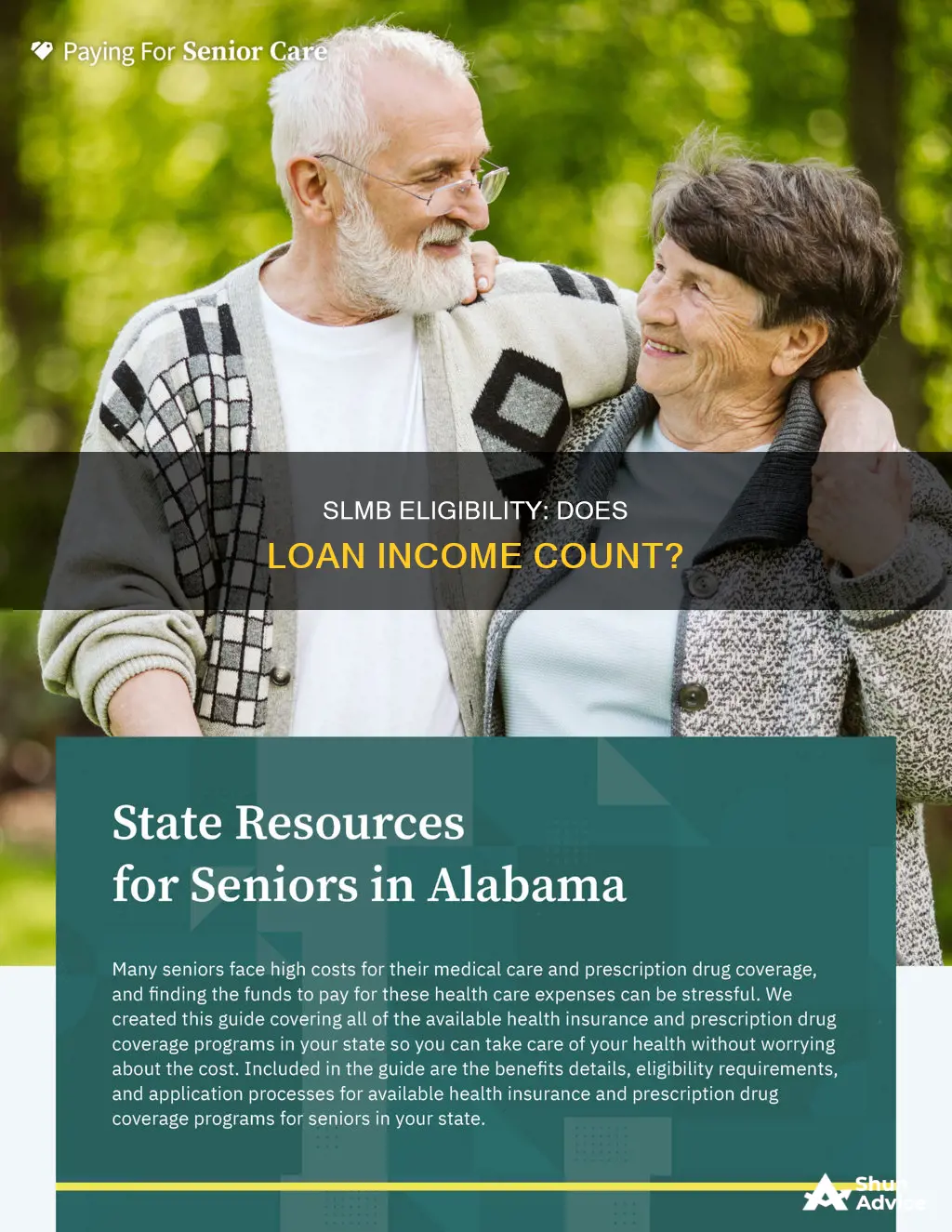
The Specified Low-Income Medicare Beneficiary (SLMB) program is a state-sponsored program that helps people with limited income and resources to pay for their Medicare Part B premiums. To qualify for SLMB, applicants must meet certain eligibility criteria, including having an income that falls below certain limits. While the specific income requirements may vary across states and change annually, it is important to note that not all types of income may be considered in the calculations. This raises the question: does income from a loan count in determining eligibility for SLMB?
| Characteristics | Values |
|---|---|
| Type of program | State-sponsored entitlement program |
| Who it is for | People with low income |
| What it helps with | Paying for Medicare Part B premiums, deductibles, and co-insurance |
| Income eligibility | Income must be between 100% and 120% of the Federal Poverty Limit |
| Income limits | Individual monthly income: under $1,526; married couple's monthly income: under $2,064 |
| Resource limits | Individual: $11,160; married couple: $17,470 |
| Additional requirements | Enrollment in Medicare Part A and B |
| Application process | Contact your state's Medicaid office |
| Application documents | Medicare card, Social Security card, birth certificate, proof of citizenship, proof of address, proof of income, bank statement |
| Application response time | 45 days |
| Additional benefits | Reimbursement for Part B premiums paid before SLMB enrollment, Medicare Part D Low Income Subsidy (Extra Help) |
What You'll Learn

SLMB eligibility criteria
The Specified Low-Income Medicare Beneficiary (SLMB) program helps individuals with low incomes to lower their out-of-pocket Medicare costs. SLMB eligibility criteria are based on income and resources, and there are limits set by the state where the applicant lives.
To be eligible for SLMB, an individual's monthly income must be under $1,526, or a married couple's monthly income must be under $2,064. These limits are based on the Federal Poverty Guidelines (FPG) and change annually, with new limits released each January. In addition, an individual must have limited countable resources, which include cash, bank accounts, stocks, bonds, and certain items. The resource limits in most states require that an individual's resources fall under $9,430 or a married couple's resources fall under $14,130.
It is important to note that SLMB eligibility also requires enrollment in Medicare Part A and Part B, and individuals must meet all other Medi-Cal Program requirements. Furthermore, SLMB applicants must be citizens or non-citizens who would otherwise be entitled to full-scope benefits if they were applying for regular Medicaid.
While most states have the same income and resource criteria, there are some exceptions. For example, Alaska and Hawaii have slightly higher income limits, and certain states may exclude additional assets from the countable resources. Therefore, it is recommended to contact the state's Medicaid office to determine specific eligibility requirements and the application process.
HR Block's Refund Anticipation Loans: What's the Deal?
You may want to see also

SLMB income limits
The Specified Low-Income Medicare Beneficiary (SLMB) program helps individuals with limited income and resources to cover their Medicare Part B premium costs. Each state sets its own income limits for SLMB eligibility, and these limits are typically based on the Federal Poverty Guidelines (FPG). While most states follow the general guidelines, some may set higher income limits or waive asset limits.
The SLMB income limits change annually and are released each January. However, state Medicaid agencies may not start using the updated guidelines until March or April, after the Centers for Medicare and Medicaid Services have formally published the figures. Additionally, there is a $20 general income disregard for all the Medicare Savings Programs (MSPs) in every state, meaning that the first $20 of monthly income is not counted towards the income limit.
The SLMB income limits for 2024 were slightly higher in Alaska and Hawaii compared to other states. To find out the specific income limits for a particular state, individuals can contact their state's Medicaid office or their State Health Insurance Assistance Program (SHIP). These organizations can provide guidance on eligibility requirements and assist with the application process.
It is important to note that SLMB eligibility also requires individuals to be enrolled or qualify for both Medicare Part A and Part B. Additionally, individuals receiving Supplemental Security Income (SSI) or State Supplementary Payment (SSP) are not eligible for SLMB.
Hyundai Warranty: Loaner Coverage and Your Rights
You may want to see also

SLMB application process
The SLMB program, or Specified Low-Income Medicare Beneficiary program, is a state-sponsored program that helps eligible individuals with their Medicare Part B premium costs.
To apply for the SLMB program, you should first contact your state's Medicaid office to understand the specific application process and requirements for your state. Each state has its own eligibility criteria and application process, and some states may have more flexible income qualifications. You can also call your State Health Insurance Assistance Program (SHIP) to determine your eligibility and get help with the application process.
Once you have determined your eligibility and the specific requirements for your state, you can begin gathering the necessary documents. These typically include:
- Medicare card
- Social Security card
- Birth certificate or other proof of citizenship
- Proof of address
- Proof of income
- Bank statement outlining your assets
After collecting the required documents, you can submit your application to your state's Medicaid office. This can often be done online, by mail, or in person. You may also be able to apply through community health centers and other organizations.
Within 45 days of filing your application, you should receive a Notice of Action informing you of your application status. If your application is approved, your SLMB coverage will begin, and your state Medicaid office will start paying your Medicare Part B premium. If your application is denied, you have the right to request a hearing to challenge the decision.
It is important to note that SLMB eligibility is based on specific income and resource limitations, which may vary from state to state and can change annually. Therefore, it is essential to review the eligibility criteria and application process for your specific state before initiating the SLMB application process.
Hospice Equipment: What's Available on Loan?
You may want to see also

SLMB enrolment
The Specified Low-Income Medicare Beneficiary (SLMB) program is a state-sponsored program that helps eligible beneficiaries with limited income and resources to pay their Medicare Part B premiums.
To enrol in the SLMB program, you must meet certain eligibility criteria and requirements. Here is a step-by-step guide to help you understand the SLMB enrolment process:
- Eligibility Criteria: To be eligible for SLMB, you must meet certain income and resource limitations. Your income must be above the QMB (Qualified Medicare Beneficiary) income limit but below the SLMB income limit. These limits vary from state to state and are based on the Federal Poverty Guidelines (FPG), changing annually. Most states use general guidelines, but some may set higher income limits or waive asset limits.
- Medicare Part A and Part B: You must qualify for or be enrolled in both Medicare Part A and Part B. If you refused Part B coverage during your initial enrolment period, you can apply at any time at the Social Security office.
- Citizenship: You must be a citizen or a non-citizen who would otherwise be entitled to full-scope benefits if applying for regular Medi-Cal. Undocumented non-citizens who only qualify for restricted benefits are not eligible.
- State-Specific Requirements: Each state has its own specific requirements and application processes. Contact your state's Medicaid office to understand the eligibility criteria and application process for your state.
- Documentation: Collect the necessary documents to provide proof of your eligibility. This typically includes your Medicare card, Social Security card, birth certificate or proof of citizenship, proof of address, proof of income, and bank statements outlining your assets.
- Application: Submit your application to your state's Medicaid office. This can often be done online, by mail, or in person. There is usually no cost to apply, and you will be enrolled in the Medicare Savings Program (MSP) for which you qualify.
- Notification: You will receive a notice from Medicare if you are approved for the SLMB program. This notice can be submitted to your Part D plan to access Extra Help benefits, which include savings on prescription drugs and a quarterly Special Enrollment Period.
- Retroactive Reimbursement: SLMB allows for retroactive reimbursement of your Part B premiums. You can receive reimbursement for premiums paid up to three months before your SLMB enrolment effective date and even for the previous calendar year if you met the eligibility guidelines.
It is important to note that SLMB enrolment does not require you to wait for specific enrolment periods. If you think you may qualify, it is recommended to apply and seek assistance from your State Health Insurance Assistance Program (SHIP) to determine your eligibility.
Illinois and the US Rule Loan: What You Need to Know
You may want to see also

SLMB benefits
The Specified Low-Income Medicare Beneficiary (SLMB) program is a state-sponsored program that provides financial assistance to those who qualify for Medicare Part A and have a limited income and resources. The program helps beneficiaries pay for Medicare Part B premiums and is available to those with income and assets below certain limits set by the state. These limits are based on the Federal Poverty Guidelines (FPG) and change annually, with new limits released each January.
To be eligible for SLMB benefits, individuals must meet specific criteria. Firstly, they must be eligible for Medicare Part A, either for free or by paying for it. Secondly, their income must be above the Qualified Medicare Beneficiary (QMB) income limit but below the SLMB income limit. This typically means having an income of up to 110% of the Federal Poverty Limit in 1993 and 1994, and up to 120% from 1995 onwards. Additionally, SLMB applicants must be citizens or non-citizens who would otherwise be entitled to full-scope benefits if they were applying for regular Medi-Cal (California's Medicaid program).
It is important to note that SLMB eligibility excludes individuals receiving Supplemental Security Income (SSI) or State Supplementary Payment (SSP). Additionally, SLMB eligibility must be determined separately for each state, as income limits and application processes may vary. Individuals can contact their state's Medicaid office or State Health Insurance Assistance Program (SHIP) to learn about specific eligibility requirements and apply for SLMB benefits.
Huntington's Loan Grace Period: All You Need to Know
You may want to see also
Frequently asked questions
SLMB stands for Specified Low-Income Medicare Beneficiary. It is a state-sponsored program that helps people with low incomes pay for their Medicare Part B premiums.
To be eligible for SLMB, you must be enrolled in Medicare Part A and your income and resources must fall below certain limits. These financial limits may vary from state to state and year to year. You can contact your state's Medicaid office to find out the current limits.
It is not clear whether income from a loan counts toward SLMB eligibility. However, SLMB eligibility is based on your monthly income and resources, and there are specific income and resource limits that must not be exceeded. It is recommended that you contact your state's Medicaid office to determine how to apply and what types of documentation you need.







